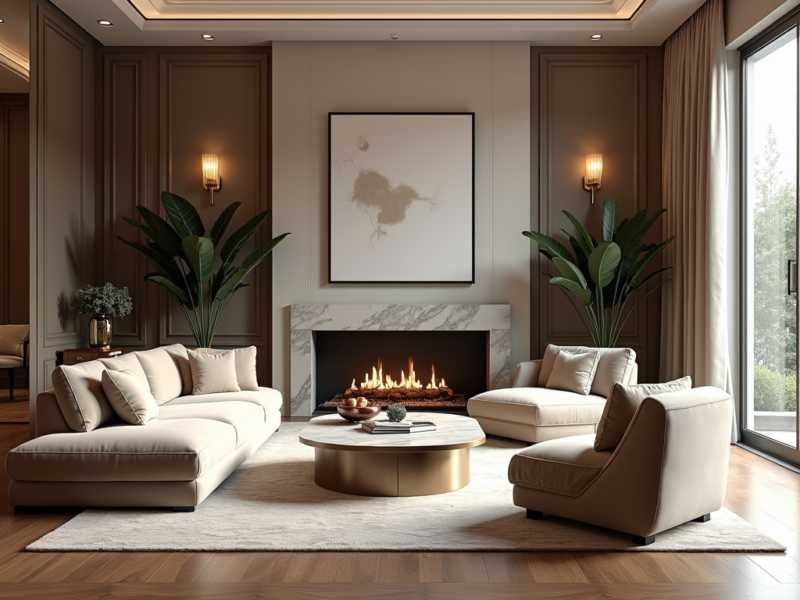Personalizing a home can transform a space from ordinary to uniquely reflective of its inhabitants. By incorporating simple touches, one can create an environment that feels both inviting and authentic. Using personal photos, meaningful artwork, and handcrafted items can significantly enhance the character of any home.
Small changes can make a big impact. For example, rearranging furniture or adding new throw pillows can create a fresh look without a complete overhaul. Personalized decor not only adds style but also tells a story and evokes cherished memories.
Additionally, integrating natural elements such as plants or using specific color palettes can elevate the ambiance. Customizing the home environment makes it a haven where individuals can feel truly at ease and connected to their space.
Maximizing Space for Personalization
Making the most of available space can enhance personalization in any home. Thoughtful furniture arrangement and the creation of multipurpose areas allow for creative expression while ensuring functionality.
Strategic Furniture Placement
Effective furniture placement can greatly impact how a space feels and functions. Arranging furniture to define distinct areas within a room promotes organization.
- Use of Angles: Positioning couches or chairs at an angle can create visual interest and open up the area.
- Rug Placement: Incorporating area rugs helps delineate spaces, adding character without permanent changes.
- Flow Consideration: Ensuring there is enough room to walk comfortably through spaces prevents clutter.
These strategies not only enhance aesthetics but also provide opportunities for incorporating personal touches through accessories, like cushions or decorative throws.
Creating Multipurpose Areas
Designing spaces that serve multiple functions is essential for maximizing area in small homes. This concept allows for flexible use while maintaining a personal atmosphere.
- Convertible Furniture: Items like sofa beds or expandable dining tables offer versatility without sacrificing style.
- Nook Development: Creating cozy reading nooks or office spaces in corners can transform underutilized areas into personal retreats.
- Storage Solutions: Utilizing storage ottomans or shelves as workspace organizers keeps areas tidy and functional.
Such arrangements enable individuals to reflect their personality through decor, while also accommodating everyday needs.
Enhancing Comfort with Textiles
Textiles play a crucial role in establishing comfort within a home. By incorporating area rugs and decorative pillows or blankets, one can create an inviting atmosphere that promotes relaxation.
Choosing the Right Area Rug
Selecting an area rug involves considering materials, size, and design. Common materials include wool, cotton, and synthetic fibers. Wool is durable and provides warmth, while cotton offers easy maintenance and breathability.
The rug size should complement the room’s layout. For a living room, a larger rug that accommodates all seating is ideal, while a smaller rug may suit spaces like a hallway or entryway.
Color and pattern can enhance the overall decor. Neutral tones can create a calming effect, while bold patterns can add visual interest. The right area rug ties the room together, adding both comfort and style.
Decorative Throw Pillows and Blankets
Throw pillows and blankets are versatile accessories that can instantly enhance comfort. Selecting a variety of textures and patterns can create a layered look.
Materials such as velvet, cotton, and linen offer different touches. Velvet provides a luxurious feel, while cotton is soft and easy to clean.
When arranging pillows, consider different sizes to add dimension. Grouping pillows in odd numbers, like three or five, often creates a more visually appealing setup.
Blankets can serve both functional and decorative purposes. Drape a cozy blanket over a couch or chair for easy access while adding warmth. This simple addition can elevate the comfort level of any seating area.
Setting the Mood with Lighting
Lighting plays a crucial role in defining the atmosphere of a space. Through strategic selection and placement, different types of lighting can create warmth, elegance, or functionality in a home.
Layering Light Sources
Layered lighting incorporates multiple sources to achieve depth and variety in illumination. This approach includes three main types: ambient, task, and accent lighting.
- Ambient lighting: Provides the general illumination needed for everyday activities. It can be achieved with ceiling fixtures, wall-mounted lights, or floor lamps.
- Task lighting: Focuses on specific areas for particular activities, such as reading or cooking. This includes desk lamps, under-cabinet lights, and pendant lights.
- Accent lighting: Highlights architectural features or artwork. Wall sconces, spotlights, and decorative table lamps serve this purpose.
Combining these types of lighting ensures that a room is not only functional but also visually appealing.
Smart Lighting Solutions
Smart lighting allows for greater control over a home’s ambiance. These systems enable users to adjust brightness and color temperature according to their needs or preferences.
- Smart bulbs: Can be integrated into existing fixtures and controlled remotely via a smartphone app or voice commands.
- Dimmers: Allow for the modification of brightness levels, offering flexibility in how light is experienced in a space.
- Automated schedules: Let users set specific times for lights to turn on or off, enhancing convenience and energy efficiency.
Investing in smart lighting enhances comfort and provides the versatility to adapt the ambiance for various occasions.
Incorporating Personal Decor
Personal decor transforms a house into a home, making it feel unique and lived-in. Selecting the right accessories and creating an impactful accent wall are key strategies for achieving this personalized touch.
Selecting Home Accessories
Home accessories play a vital role in expressing individual style. When choosing decorative items, focus on pieces that resonate personally, such as:
- Artwork: Select paintings or prints that reflect personal interests or memories.
- Photographs: Use framed photos of cherished moments or loved ones, displayed on shelves or walls.
- Textiles: Incorporate throw pillows, blankets, or rugs that add texture and color to spaces.
It’s essential to maintain a coherent color scheme across these items to ensure harmony. Arranging accessories in groups, using varying heights and varying textures, can create visual interest without overwhelming a space.
Creating an Accent Wall
An accent wall enhances the aesthetic appeal of a room and adds depth. Here are effective approaches for designing one:
- Color: Choose a bold color that complements the existing palette. Shades like navy, emerald, or even a rich burgundy can create a striking focal point.
- Wallpaper: Consider patterned wallpaper to introduce character. Geometric, floral, or even textured wallpapers can provide dramatic flair.
- Gallery Wall: Curate a collection of frames featuring art, photography, or mirrors to personalize the accent wall further.
When creating an accent wall, ensure it aligns with the overall decor style. The selected wall should draw attention without clashing with surrounding elements, fostering a beautiful and cohesive home environment.



